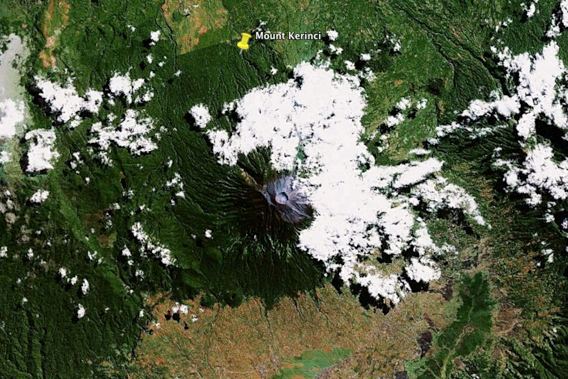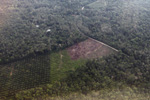
Mount Kerinci, Sumatra’s largest volcano, is a part of Kerinci Seblat National Park. Image courtesy of Google Earth.
We initially reported that Kerinci Seblat National Park has been closed to the public since 2004 due to volcanic activity. However, the park itself is not closed, but only the peak of the volcano, Mount Kerinci, which lies within the park, is.
A plan to build four wide roads through Kerinci Seblat National Park in the Indonesian island of Sumatra threatens one of the world’s most viable populations of the Critically Endangered Sumatran tiger subspecies (Panthera tigris sumatrae), reports the AP. Less than 500 Sumatran tigers remain in the wild with the population continuing to decline due to habitat loss from palm oil and paper plantations, poaching, and prey declines.
According to conservationists the roads would open up new areas for poaching and illegal logging, while creating barriers for tigers.
Mahendra Shrestha of Save the Tigers in Washington D.C. told the AP that the road proposal made a “mockery” of Indonesia’s signing of the Global Tiger Recovery Program. Last year 13 tiger range nations, including Indonesia, agreed to double wild tiger populations worldwide by 2022.
Local officials want the 40-foot roads for ‘evacuation routes’ in case of emergencies. This would double the number of roads in the park.
This is not the first proposed road project in a protected area to concern tiger conservationists. A proposed road through Nam Et Phou Louey National Park in Laos could imperil the world’s only known breeding population of Indochinese tigers.
In Sumatra, Kerinci Seblat National Park is home to many more species than Sumatran tiger, including Critically Endangered Sumatran rhinos; Sumatran elephants and Malaysian tapirs, both Endangered; and Sunda clouded leopards and sun bears, both Vulnerable. The parks contains thousands of other species including nearly 400 birds.
Related articles
Pulp and paper firms urged to save 1.2M ha of forest slated for clearing in Indonesia

(03/17/2011) Indonesian environmental groups launched a urgent plea urging the country’s two largest pulp and paper companies not to clear 800,000 hectares of forest and peatland in their concessions in Sumatra. Eyes on the Forest, a coalition of Indonesian NGOs, released maps showing that Asia Pulp and Paper (APP) and Asia Pacific Resources International Limited (APRIL) control blocks of land representing 31 percent of the remaining forest in the province of Riau, one of Sumatra’s most forested provinces. Much of the forest lies on deep peat, which releases large of amount of carbon when drained and cleared for timber plantations.
New road project to run through Laos’ last tiger habitat
(03/15/2011) A new road project in Laos will run through the nation’s only protected area inhabited by breeding tigers, Nam Et Phou Louey National Park, reports the Vientiane Times. With only about two dozen tigers (Panthera tigris) left in the nation, conservationists fear that the road will harm the fragile population, which is known to be breeding. However, local officials say the road is necessary to improve access to remote villages and alleviate poverty in the region, which is among the worst in the province.
Tiger summit reaches bold agreement and raises $300 million
(11/24/2010) The summit to save the world’s biggest cat, and one of the world’s most popular animals, has agreed to a bold plan dubbed the Global Tiger Recovery Program. Meeting in St. Petersburg, 13 nations have set a goal to double the wild tiger’s (Panthera tigris) population worldwide by 2022. Given that tiger numbers continue to decline in the wild, this goal is especially ambitious, some may even say impossible. However, organizations and nations are putting big funds on the table: around $300 million has already been pledged, including $1 million from actor, and passionate environmental activist, Leonardo Dicaprio.